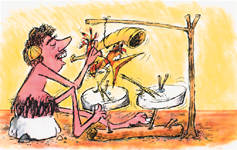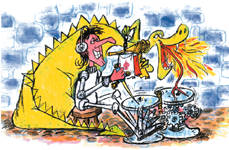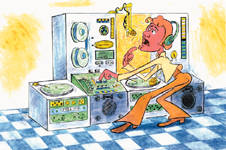From Human Jukebox to DJ Artist
Everything evolves or dies. Some art forms, such as painting, are minimally
influenced by the advance of technology. Others, such as the production
of home theater experiences, are dependent on technological advances. Some
technological advances allow art forms to acquire entirely new dimensions,
which are independent variables.
DJ mixing is a relatively new field, but has quickly matured with advances
in mixer and player technology, and with music tempo stability resulting
from electronic drums. Some DJs are content to remain human jukeboxes or
personality jocks, who entertain with their wit, instead of becoming performance
artists who can entertain without saying a word. While there will always
be a market for personality jocks, the future holds the greatest opportunities
for the DJ Artist who can spin new musical tapestries through harmonic mixing.
DJs will not be considered "artists" until they start performing artistically.
As long as we continue to mix tunes together randomly, with no concern for
the sour overlays and dissonance created by random mixing, we have no more
claim to "artistry" than would a blind painter.
Art is about form, texture, movement and composition. A DJ mixing harmonically
controls these elements to produce a cohesive whole, much as a composer
may write a duet: both parts must be harmonically related as well as rhythmically
synchronized. To do otherwise, to be concerned only with rhythm, is pseudo-artistry
at best.
The world's top DJs recognize the importance of mixing in key:
• Shep Pettibone, in his January 1993 interview in DJ Times (page 28),
states "Well there's more than just BPMs. There's the way you put songs
together musically. The music should fit. Some people call themselves good
club DJs and I listen to them and hear clashing music or an A-Flat going
into a C. I don't get it. It doesn't go musically."
• Junior Vasquez, in his January 1997 interview in DJ Times (page 62),
states "Another important thing about becoming a good DJ is knowing the
keys of songs. I learned that over a period of time."
Since harmonic mixing is as easy as telling time, the only thing preventing
most technically competent jocks from becoming mix artists is their desire
for excellence.
Ancient

Before there was mixing, there was the human
jukebox. Working with perhaps only one turntable, this DJ was primarily
an entertainer who happened to play music. His (or rarely, her) skill
was in entertaining an audience with amusing patter. Even with two turntables
there was no attempt to blend songs together. As recently as the late
1970's, this was the dominant DJ lifeform.
There was zero-dimensional mixing, because it rarely
occurred (except by accident). Mixing was much more difficult because:
• Turntables rarely
had speed stability until the arrival of the original Technics 1200's.
• Music rarely had
speed stability until electronic drums became affordable in the mid-1980's.
• Affordable mixers,
with phono pre-amps and suitable faders, were rare until GLI entered this
market.
HOME THEATER ANALOGY: Before the arrival of B&W
commercial TV, a "home theater" consisted of only a radio. It too was
zero-dimensional because a theater requires visual input.
Medieval
 As
DJ's displaced bands as the primary form of club entertainment, two turntables
and a mixer became necessary. The flow between songs became important as
DJ's strived to maintain musical continuity. The jock would fade a new song
in over the trailing edge of the old song, often with catastrophic results.
Since neither beats nor keys were synchronized, the brief overlays could
sound like train wrecks. This technique is still common today with radio
stations. As
DJ's displaced bands as the primary form of club entertainment, two turntables
and a mixer became necessary. The flow between songs became important as
DJ's strived to maintain musical continuity. The jock would fade a new song
in over the trailing edge of the old song, often with catastrophic results.
Since neither beats nor keys were synchronized, the brief overlays could
sound like train wrecks. This technique is still common today with radio
stations.
This style of mixing created a new variable (dimension)
when it connected two different songs for a short interval. This brief overlay
created the first dimension of mixing: a new sound created by the interaction
of two separate sources. This new sound was rarely musical (except by chance),
because it lacked the basic components of Western music: rhythm, harmony
and melody.
To avoid the "train wreck effect," some DJ's developed
spot mixing techniques which provided continuity between songs. Although
spot mixing did not permit any overlays, the rhythmic flow between songs
could be maintained. Spot mixing is still used today when uneven tempos
or drastic speed changes do not permit overlays.
HOME THEATER ANALOGY: Black and white TV created the
first home theater dimension: movement of gray forms on a screen.
Renaissance
 The
evolution of turntable and mixer technology coincided with the appearance
of rap as a distinct vocal form. High torque turntables now permitted DJ's
to backspin a record while the turntable platter maintained speed. Source
faders permitted DJ's to cut (insert short musical segments from a second
source) and scratch (rapidly and rhythmically repeat single beats from a
second source) with confidence. This style allowed the creation of new rhythms,
and became especially popular with teenagers. The
evolution of turntable and mixer technology coincided with the appearance
of rap as a distinct vocal form. High torque turntables now permitted DJ's
to backspin a record while the turntable platter maintained speed. Source
faders permitted DJ's to cut (insert short musical segments from a second
source) and scratch (rapidly and rhythmically repeat single beats from a
second source) with confidence. This style allowed the creation of new rhythms,
and became especially popular with teenagers.
Adults were usually less enthused with scratching and cutting, because it
often destroyed the musical integrity (melody, harmony and rhythm) of favorite
songs. Since teenagers usually formed fewer attachments with specific songs,
they were often more receptive to the mutation of music.
Cutting and scratching became part of record production with "The Adventures
of Grandmaster Flash on the Wheels of Steel" in 1981, and now was firmly
established in hip-hop culture. The use of drum machines became widespread
in the mid-1980's. Soon thereafter, sampling technology became cheap enough
to permit electronic "cutting" and the insertion of atonal segments into
electronic drum patterns.
One might say that technological advances actually hurt the evolution of
R&B because it soon allowed rap record production without the involvement
of any musicians. While early rap track s were usually original or derivative
studio band productions, musical integrity became optional. Rhythm was paramount;
melody and harmony were dispensable. Rap achieved crossover success. To
music lovers' surprise, rapper Biz Markie hit #9 on Billboard magazine's
pop chart (#37 on the R&B chart) in 1989 with his seminal recording
of "Just A Friend," in which his singing was unpretentious, to say the least.
The hip-hop market permitted anything to mix with anything else, as long
as it was on beat.
Mixing now had a second dimension: synchronization of sources. Two songs
could be connected indefinitely by rhythmically overlaying small bits and
pieces of one song on another song. Each overlay had to be very short, however,
to avoid conflicting beats.
HOME THEATER ANALOGY: Adding color to B&W scenes created the second
dimension: Not only did home theater forms move, but now they moved in color.
Modern
 While technological advances may have detracted from musical integrity in the
post-disco era, it undoubtedly helped the evolution of mixing. Most dance
music used electronic drums, which locked in a consistent tempo indefinitely.
Quartz lock and variable pitch turntables (and ultimately CD players) now
allowed DJ's to overlay long segments of different records, as long as they
could be synchronized. While technological advances may have detracted from musical integrity in the
post-disco era, it undoubtedly helped the evolution of mixing. Most dance
music used electronic drums, which locked in a consistent tempo indefinitely.
Quartz lock and variable pitch turntables (and ultimately CD players) now
allowed DJ's to overlay long segments of different records, as long as they
could be synchronized.
Once his beat mixing technique was developed, the
DJ could overlay complete phrases (8+ counts) and even verses (32 counts).
He soon found, however, that synchronization was not enough. If the desired
segments of both songs contained melodies, the result was usually unpleasant
because of clashing keys. The determined DJ solved this dilemma by trial
and error: He tried different combinations until he found compatible songs.
He did not know that only 25 percent of all songs are harmonically compatible.
He soon learned the value of neutral "free beat" segments
where only percussion played. Free beats could be mixed over melodies without
clashing. The absence of these segments made songs more difficult to mix.
Remix services, such as Hot Tracks and Ultimix, appeared to solve the problem.
Each remixed song would usually have a key-neutral intro, break(s), and
outro, which now allowed eight bars (32 counts) of beat mixing without clashing.
The primary limitation of basic beat-mixing is dependence
on free-beat segments. It's sort of like traveling around the United States
- but only by railroad. Free-beat segments are like railroad tracks: You
can go any place you want as long as it is serviced by tracks. Harmonic
mixing is like traveling by helicopter: You can go any place you want, period.
Basic beat mixing created the third dimension of mixing,
rhythm, because full synchronization permitted complete overlays - as long
as melodies did not clash.
HOME THEATER ANALOGY: Stereo TV brought the third
dimension, width, to home theater, when it created a horizontal stage along
which sound could be pinpointed.
Futuristic
 In 1986 a visionary named Stuart Soroka introduced the DJ world to the concept
of harmonic mixing. He published Harmonic Keys magazine in Key West, Florida,
and rapidly expanded a subscriber base through advertising in DJ magazines
such as Dance Music Report. The most advanced DJs of that period
soon learned the value of mixing in key: It allowed them to complete the
sonic tapestries they sought to create, but in which they had been thwarted
by the realities of incompatible keys. In 1986 a visionary named Stuart Soroka introduced the DJ world to the concept
of harmonic mixing. He published Harmonic Keys magazine in Key West, Florida,
and rapidly expanded a subscriber base through advertising in DJ magazines
such as Dance Music Report. The most advanced DJs of that period
soon learned the value of mixing in key: It allowed them to complete the
sonic tapestries they sought to create, but in which they had been thwarted
by the realities of incompatible keys.
Harmonic programming was difficult, however.
It required DJs to either memorize the relationship of 24 different keys,
or to constantly refer to a table of compatible keys.
For their $180.00 annual subscription, DJs received a magazine every six
to eight weeks, and jacket labels for their records. Each issue of the magazine
contained key/speed information for hundreds of current and older songs.
The dance music universe was increasingly covered, until Harmonic Keys claimed
to have more than 3,000 keys in its anthology database in October 1987.
Subscribers were severely disappointed in early 1988 with news that Harmonic
Keys had stopped publication. Office phones were disconnected, and rumors
were rampant that Stuart Soroka had died. Dance Music Report, as the primary
advertising vehicle for Harmonic Keys, was barraged with outrage from hundreds
of DJs who had each paid $180.00 to Stuart and were left with nothing. Harmonic
mixing quickly acquired a bad name.
A California DJ, named Mark Davis, subscribed to Harmonic Keys soon after
it emerged. Since his primary musical area was R&B, he noticed that
the magazine was somewhat deficient in this area. Working with local musicians,
he took the initiative to key recent R&B songs, program a number of
sets, and submit the information to Harmonic Keys. His efforts were rewarded
in July 1987 when Harmonic Keys printed a "R&B Classic Issue" featuring
his work.
With the demise of Harmonic Keys, he continued keying
music and offered this information to the DJ community under the name of
Camelot Sound. The database now contains
over 32,000 songs, and is updated monthly. He devised an extremely simple
harmonic programming system based on the Circle of Fifths. Using this system,
a DJ no longer had to memorize or refer to the difficult key charts used
by Harmonic Keys. This "Easymix System" gave
every key a number (keycode) between 1 and 12, like numbers on a clock.
To find a compatible song from any keycode, a DJ needed only to select another
song within one keycode of the current song. Now anyone who could tell time
could program harmonically.
Harmonic mixing brings the fourth dimension, harmony,
to DJ mixing technique, when it allows different melodies to be played simultaneously
without clashing.
HOME THEATER ANALOGY: Surround sound brought a fourth
dimension, depth, to home theater audio presentations. A source could be
localized at any point within the acoustic plane created by properly adjusted
Dolby Digital (or DTS) equipment.
END.
|